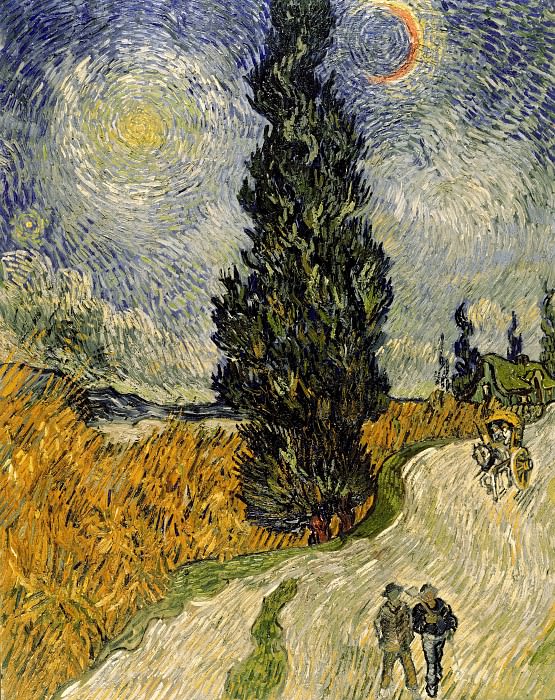Road with Cypress and Star Vincent van Gogh (1853-1890)
Vincent van Gogh – Road with Cypress and Star
Edit attribution
Download full size: 3326×4200 px (5,9 Mb)
Painter: Vincent van Gogh
Location: Kröller-Müller Museum, Otterlo.
Vincent Van Gogh painted The Road with Cypresses and a Star while he was already in a madhouse near Saint-Rémy. It was the last year of his life, with periods of madness interspersed with periods of enlightenment. Van Gogh produced a hundred and fifty paintings and over a hundred drawings during this last year. The main paintings of the last year are landscapes and still-lifes, in which the nervous tension combined with dynamism is particularly noticeable.
Description of Vincent van Gogh’s painting The Road with Cypresses and a Star
Vincent Van Gogh painted The Road with Cypresses and a Star while he was already in a madhouse near Saint-Rémy. It was the last year of his life, with periods of madness interspersed with periods of enlightenment. Van Gogh produced a hundred and fifty paintings and over a hundred drawings during this last year.
The main paintings of the last year are landscapes and still-lifes, in which the nervous tension combined with dynamism is particularly noticeable. In the painting he describes, there is a long winding road leading past an old hotel with barely visible light in the windows. In the center of the painting is a huge straight cypress, gloomy, like the state of mind of the artist at this period.
The upper part of the canvas is a majestic panorama: tall yellow reeds created by long brush strokes, sharply outlined trees and clouds. The precision and filigree in his work remained with Van Gogh even during the period when he created 2-3 paintings and several drawings in a week.
A psychologist might find in this painting a reflection of the artist’s fears. The road passes the hotel and goes nowhere, the field and the sky vie for unfriendliness. Several people can be seen on the road.
The work is also interesting for astronomers. The artist depicted the new moon, a narrow sickle turned toward the cypress. This is what the moon looked like at the time of the painting in mid-April 1890. On the left, the artist depicted two other objects, Mercury and Venus. Interestingly enough, he drew these two planets in mirror form. However, the moon remained upside down.
This wasn’t Van Gogh’s only experiment with an inverted sky. One of the most famous such paintings is Starry Night, which has a star spiral at its center, resembling a mirror image of a galaxy. Today it’s unlikely to be possible to understand what the inverted sky meant to the artist. He died three months later.
Кому понравилось
Пожалуйста, подождите
На эту операцию может потребоваться несколько секунд.
Информация появится в новом окне,
если открытие новых окон не запрещено в настройках вашего браузера.
You need to login
Для работы с коллекциями – пожалуйста, войдите в аккаунт (open in new window).




















You cannot comment Why?
In Vincent van Goghs painting Road with Cypress and Star, the viewer is presented with a dramatic nocturne scene. Dominating the center is a tall, dark cypress tree, its sinuous form reaching towards the swirling sky. One side of the canvas is awash in the golden hues of a wheat field, vibrantly rendered with thick, textural brushstrokes that convey movement and texture. A winding road cuts through the landscape, appearing almost white and illuminated, suggesting the faint light of night.
Along this road, two figures, small in scale, are seen walking, their forms rendered with simple, dark outlines. Further in the distance, a horse-drawn cart can be seen, hinting at the presence of human activity amidst the vastness of nature.
The sky is a spectacle of Van Goghs signature style: a turbulent expanse of deep blues, whites, and yellows, with swirling patterns that suggest a cosmic energy. A bright, haloed moon or sun, radiating intense light in concentric circles, occupies the upper left, while a crescent moon, tinged with orange, is visible in the upper right. Small, star-like dots are scattered across the sky, further adding to the celestial drama.
Subtexts:
The painting is rich with emotional and symbolic subtexts often associated with Van Goghs work:
Overall, Road with Cypress and Star is a deeply emotional and spiritual painting that invites contemplation on themes of life, death, humanitys place in the universe, and the expressive power of nature.